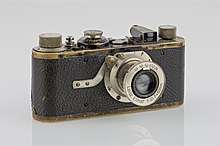Oskar Barnack
| Oskar Barnack | |
|---|---|
 Oskar Barnack | |
| Born |
1 November 1879 Lynow, Nuthe-Urstromtal, Germany |
| Died |
16 January 1936 (aged 56) Bad Nauheim, Germany |
| Nationality | Germany |
| Occupation | Engineer |
| Engineering career | |
| Projects | Camera |

.jpg)



Oskar Barnack (Nuthe-Urstromtal, Brandenburg, 1 November 1879 – Bad Nauheim, Hesse, 16 January 1936) was an inventor and German photographer who built, in 1913, the first 35 mm camera subsequently called Ur-Leica at Ernst Leitz Optische Werke (the Leitz factory) in Wetzlar.[1]
Life and career
Barnack was an engineer at the Leitz company and suffered from asthma, so he proposed reducing the size and weight of cameras in order to be able to take photographs in his travels. In 1924 the name given to the camera was Leica, an anagram obtained from Leitz Camera. It was released at the Leipzig Fair in 1925.
Between 1913 and 1914 Barnack adapted for photographic use the format of the 35 mm film that was used in the cinema, by building the first small-format camera. The perforated film rollers on the side of the film allowed for a larger number of photos without the need to change the plate for each photograph. In addition, this film was transported horizontally, extending the frame size to 24×36 mm with a 2:3 aspect ratio, instead of the 18x24 mm of cameras that carried the film vertically. Negatives in this small format could be enlarged to obtain larger positive images in a location adapted for positivization. For this to be effective, the camera had to have a high quality lens capable of producing negatives that could be enlarged into positives of the same quality definition as cameras that used a larger format film. Barnack tried various types of lens in order to find the one that would create the best quality images. Initially a Zeiss Tessar was tested, but this had been designed for the 18×24 mm film format, so the 24x36 mm Leica negatives were partially covered. Later, a Leitz Mikro-Summar lens of 1:4,5 and 42 mm was tested for the prototype, but in order to achieve the necessary resolution for a satisfactory enlargement, the 24x36 mm format needed a specially designed lens. Leica's first suitable lens that emerged consisted of a 50 mm f/3.5 design based on the "Cooke triplet".
In 1923 Barnack convinced his boss, Ernst Leitz II, to make a series of 31 pre-production cameras for the factory and for outdoor photographers. Although the prototypes received a mixed reception, Ernst Leitz decided in 1924 to produce the camera. It was a success when presented at the Spring Fair of Leipzig in 1925 as the Leica I (Leitz camera).
Barnack was also one of the first photographers to create news images in which the relationship of people to their surroundings could be seen. In this style he made what is considered the first news image made with a 35 mm camera, showing the flood caused by the Lahn River in Wetzlar.
In 1979, on the occasion of the centenary of its birth, the Leica Oskar Barnack Prize was awarded, endowed with 5000 euros and awarded in July at the Meetings of Arles.
Oscar Barnack Prize
An international jury awards the Leica Oskar Barnack Prize to professional photographers, whose powers of observation capture and express the relationship between man and the environment in the most graphic way in a sequence of a minimum of 10 to a maximum of 12 images.
Input presentations must be an autonomous series of images in which the photographer perceives and documents the interaction between man and the environment with an acute vision and contemporary visual style: creative, breakthrough and innovative. Only one entry per photographer is accepted. In addition to these categories of "Leica Oskar Barnack Prize" and "Leica Oskar Barnack Award Newcomer Prize", ten finalists will be awarded with a cash prize of 2,500 euros for their series. [2]
The winner of the main category "Leica Oskar Barnack Award" receives a cash prize of 25,000 euros and also a Leica M camera and a loan worth 10,000 euros.[2]
References
- ↑ Lance Day, Ian McNeil, ed. (1996). Biographical Dictionary of the History of Technology. Routledge. ISBN 0-415-19399-0.
- 1 2 "International Photo Contest – The Leica Oskar Barnack Award". International Photo Contest – The Leica Oskar Barnack Award. Retrieved 2017-12-13.
External links
| Wikimedia Commons has media related to Leica. |